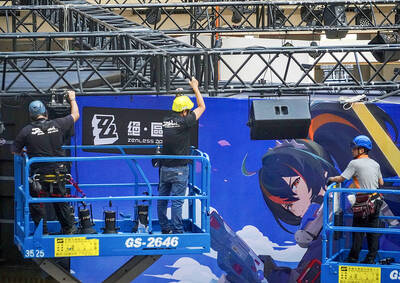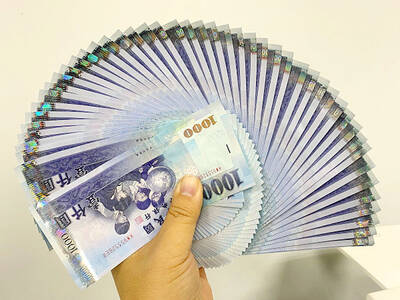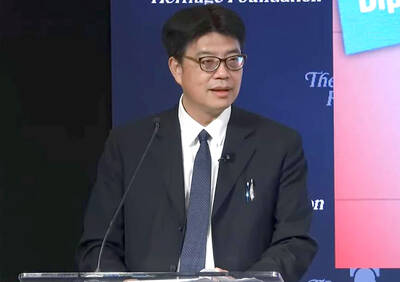Being a star engineering student at the top-notch science university here wasn't enough to exempt Viktor Gordeyev from his physical education class.
Gordeyev, a specialist in airplane piston engines, sweated it out with everyone else, running laps in lumbering heavy boots in this town in the foothills of the Ural Mountains.
He vowed to find an easier way. Eventually, he found one -- or at least came close.

PHOTO: NY TIMES
Gordeyev invented a gasoline-powered boot that looks like pogo sticks that strap to your shins, and they work on the same principle as the air-cushioned basketball shoe. But rather than being dismissed as a crackpot invention, his boots -- which use tiny pistons -- became classified as a Russian military secret until 1994.
Now, they have been held up as a symbol of both Russia's deep and rich scientific traditions and the country's inability to convert that talent into useful -- and commercial -- merchandise outside of the weapons business.
Many government officials, Russian scientists and economists are focusing these days on the need to generate new sources of growth to diversify the country's economy away from oil -- the unsteady source of Russia's recent prosperity. And there is a growing consensus that entrepreneurialism has promise but faces serious obstacles, including no vibrant mechanism to bring together venture capitalists, inventors and entrepreneurs to develop viable commercial products.
In February, President Vladimir Putin implored the country's most prominent businesses to branch out and invest in innovation and science. German Gref, the minister of economic development, often says Russia's scientific base distinguishes it from other emerging market economies in India, China and Brazil, even though Russia is often compared to them.
But as part of a series of pointed articles, the Russian edition of Popular Mechanics magazine argued that Gordeyev's thwarted attempt to commercialize the shoes is a symbol of the country's failure to tap its considerable scientific talent for profitable business ideas.
The dream Gordeyev conceived in 1974 to run faster and jump higher without getting tired might never have become a popular option for commuters or even caught on as a sport. But unlike the Segway, the self-balancing scooter invented in the US, it never had a chance.
Instead, the boots became a military secret, as generals envisioned soldiers running swiftly and effortlessly alongside armored vehicles.
The boots were declassified in 1994, and Gordeyev and his partners imagined growing rich by selling their invention to a lazy public. Instead, the company went out of business last year.
Like the boots, Russian scientists are still trying to gain traction in the capitalist world. A company in Saratov making a novel transport airplane with no tail, called the "flying saucer," never got off the ground.
Russia also has other examples of good ideas later bungled in the process of commercialization.
The Russian inventor of the "Tetris" video game was unable to patent his invention, and thus lost out on huge amounts of money. Russian engineers invented submersible pumps for oil wells, but failed to invest in their development; now Russian companies buy Western models from Halliburton.
And, in contrast to the US, venture capital firms and startup companies in Russia have not congregated near technology universities. Russian computer programmers, successful in Silicon Valley, are best known at home for hacking.
"Venture capital firms are starting to work here, but as a rule, if something comes to their attention it is an exception," said Igor Belousov, a Hewlett-Packard executive who coordinates the company's research at Russian universities.
Meanwhile, natural resources account for 80 percent of Russia's export revenue; crude oil and natural gas alone account for 65 percent.
To encourage foreign companies to invest in cities rich in scientific talent, Gref's ministry is setting up technology parks with tax breaks in St. Petersburg, Moscow, Nizhny Novgorod and Novosibirsk.
In another example, Boris Gryzlov, the speaker of parliament, said last month that his political party, United Russia, should help Russian inventors find markets for their ideas. The program is called the Idea Factory.
Like so much else in Russia these days, it envisions a big role for the Kremlin in venture capital; some 30 committees would recommend scientists for state grants. That approach is not surprising, given the country's history of channeling industrial innovation into its military -- the first home of Gordeyev's shoes.
For now, though, the boots remain a curiosity, without the wider distribution their owners hoped for.
"Everything that would happen in an engine happens when you step down" in the boots, said Rustam Enikeev, the dean of the faculty of internal combustion at the Ufa State Aviation Technical University.
A step down compresses air in the shoe as in a typical sneaker, said Enikeev, who was a designer on the project. But then, a tiny carburetor injects gasoline into the compressed air and a spark plug fires it off. Instead of fastening a seat belt, the institute's test runner, Marat Garipov, an assistant professor of engineering, strapped on shin belts at a recent demonstration. Then he flicked an ignition switch.
Before running down a university corridor, he jumped in place a few times to warm up the engine. Garipov then ran laps for about 10 minutes, going about 19kph, with the two-stroke boots emitting small puffs of exhaust.
A test runner once topped out at 34.9kph, despite the risk of shooting off balance.
The tanks in the shoes hold a third of a cup of gasoline each and will take the runner 4.8km; that means the boots get about 29.8km per liter.
But even after years of research, gasoline-assisted running remains dangerous.
"The worst situation is when the spark fires as the runner just lands, and the force of the blast is absorbed by his body," Garipov explains flatly.
The two powerful engines tend to throw a wearer off balance or cause knees to buckle.
Gordeyev, the inventor, now 61 and retired, disagrees that the boots are dangerous and still has visions of their mass adoption.
"We've been running in them for years and we haven't had one trauma," he said in a telephone interview. "The latest version operates smoothly. It will become a device for moving humanity. It's a means of personal transportation."
First, the institute tried to interest the Soviet army.
"We ran in the corridor of the general staff building, in front of the generals" and the defense minister, Enikeev said. "They liked it, and were even a little frightened."
An order came down for the paratroop command to test the boots, and the design became classified. This gave the university access to government laboratories in Moscow, including those of the space agency.
One result of the Russian space agency testing was a calculation that the energy in calories used to move the 907g boot at a run would exceed the energy input from the gasoline engine. That meant, it was more tiring to run with the motorized footwear than without it, undermining the original rationale.
Only if the weight could be reduced to below 907g per boot would the wearer have a net energy gain. So far they have failed.
After the shoes were declassified in 1994, when capitalism was beginning to sweep across Russia, the inventors decided to market the boot.
A former student, Anfis Saibakov, formed a company called Ekomotor to design a commercial version. He imagined people might want to commute in the boots, as they do on bicycles or rollerblades. None of this happened.
When Saibakov demonstrated the boots at Disney World in Florida in 1998, safety was a concern, he said, and the company lacked money to fine-tune the product.
"They don't have characteristics that would allow an ordinary person to use them," Saibakov said glumly, admitting that running in the shoes would always mean "taking certain risks."
"They should work like a Kalashnikov," he said. "Reliable in anybody's hands."

Taiwan is projected to lose a working-age population of about 6.67 million people in two waves of retirement in the coming years, as the nation confronts accelerating demographic decline and a shortage of younger workers to take their place, the Ministry of the Interior said. Taiwan experienced its largest baby boom between 1958 and 1966, when the population grew by 3.78 million, followed by a second surge of 2.89 million between 1976 and 1982, ministry data showed. In 2023, the first of those baby boom generations — those born in the late 1950s and early 1960s — began to enter retirement, triggering

ECONOMIC BOOST: Should the more than 23 million people eligible for the NT$10,000 handouts spend them the same way as in 2023, GDP could rise 0.5 percent, an official said Universal cash handouts of NT$10,000 (US$330) are to be disbursed late next month at the earliest — including to permanent residents and foreign residents married to Taiwanese — pending legislative approval, the Ministry of Finance said yesterday. The Executive Yuan yesterday approved the Special Act for Strengthening Economic, Social and National Security Resilience in Response to International Circumstances (因應國際情勢強化經濟社會及民生國安韌性特別條例). The NT$550 billion special budget includes NT$236 billion for the cash handouts, plus an additional NT$20 billion set aside as reserve funds, expected to be used to support industries. Handouts might begin one month after the bill is promulgated and would be completed within

The National Development Council (NDC) yesterday unveiled details of new regulations that ease restrictions on foreigners working or living in Taiwan, as part of a bid to attract skilled workers from abroad. The regulations, which could go into effect in the first quarter of next year, stem from amendments to the Act for the Recruitment and Employment of Foreign Professionals (外國專業人才延攬及僱用法) passed by lawmakers on Aug. 29. Students categorized as “overseas compatriots” would be allowed to stay and work in Taiwan in the two years after their graduation without obtaining additional permits, doing away with the evaluation process that is currently required,

IMPORTANT BACKER: China seeks to expel US influence from the Indo-Pacific region and supplant Washington as the global leader, MAC Minister Chiu Chui-cheng said China is preparing for war to seize Taiwan, Mainland Affairs Council (MAC) Minister Chiu Chui-cheng (邱垂正) said in Washington on Friday, warning that Taiwan’s fall would trigger a regional “domino effect” endangering US security. In a speech titled “Maintaining the Peaceful and Stable Status Quo Across the Taiwan Strait is in Line with the Shared Interests of Taiwan and the United States,” Chiu said Taiwan’s strategic importance is “closely tied” to US interests. Geopolitically, Taiwan sits in a “core position” in the first island chain — an arc stretching from Japan, through Taiwan and the Philippines, to Borneo, which is shared by